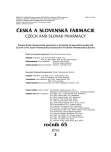-
Medical journals
- Career
The evaluation of the prevalence of constipation at the Centre of clinical gerontology
Authors: Pavla Pančevová; Martin Vodička; Karel Vašut; Milan Forejtar
Published in: Čes. slov. Farm., 2016; 65, 78-81
Category: Original Articles
Overview
Constipation is a disease which increases in the senior population and is a common complication for hospitalised patients. Among the risk factors are age, female gender, immobility, diet, fluid intake and polypharmacotherapy. The aim of the study was to analyse the prevalence of constipation according to the used drugs and known risk factors in a population with a high prevalence of constipation. In the department of clinical gerontology, observational prevalence point study was performed using a questionnaire involving 100 patients based on the patient’s subjective perception of constipation. Prevalence of constipation was determined according to the drug categories and individual drugs, gender, age, mobility, diagnosis, diet and fluid intake. There were 59 patients who suffered from constipation. A high prevalence of constipation was associated with the diet, the principal diagnosis, and mainly the use of drugs. Among the drugs associated with constipation were the calcium channel blockers of 21 patients out of 28, HMG-CoA reductase inhibitors of 22 patients out of 30, drugs for the treatment of increased urinary frequency and incontinence of 6 patients out of 6 and bisoprolol of 10 patients out of 11. Hospitalisation of seniors is connected with the high prevalence of constipation that is increased by the use of drugs that influence constipation. A change in the therapeutic value of drugs should be taken into consideration during the pharmacotherapy of this group of patients.
Key words:
constipation • risks factors for constipation • drug-induced constipation
Sources
1. Fosnes G. S., Lydersen S., Farup P. G. Constipation and diarrhoea – common adverse drug reactions? A cross sectional study in the general population. BMC Clinical Pharmacology 2011; 11, 2.
2. Peppas G., Alexiou V. G., Mourtzoukou E., Falagas M. E. Epidemiology of constipation in Europe and Oceania: a systematic review. BMC Gastroenterology 2008; 8, 5.
3. Andromanakos N., Skandalakis P., Troupis T., Filippou D. Constipation of anorectal outlet obstruction: Pathophysiology, evaluation and management. Journal of Gastroenterology and Hepatology 2006; 21(4), 403–412.
4. Gallagher P., O’Mahony D. Constipation in old age. Best Practice & Research Clinical Gastroenterology 2009; 23(6), 875–887.
5. van Dijk K. N, De Vries C. S., Van den Berg P. B., Dijkema A. M., Brouwers J. R., De Jong-Van den Berg L. T. Constipation as an adverse effect of drug use in nursing home patients: an overestimated risk. British Journal of Clinical Pharmacology 1998; 46(3), 255–261.
6. Gandell D., Straus S. E., Bundookwala M., Tsui V., Alibhai S. M. Treatment of constipation in older people. Canadian Medical Association Journal 2013; 185(8), 663–670.
7. Talley N. J., Jones M., Nuyts G., Dubois D. Risk factors for chronic constipation based on a general practice sample. The American Journal of Gastroenterology 2003; 98(5), 1107–1111.
8. Namirah J., Zone-en L., Olden K. Diagnostic approach to chronic constipation in adults. American Family Physician 2011; 84(3), 299–306.
9. Folstein M. F., Robins L. N., Helzer J. E. The Mini-Mental State Examination. Archieves General Psychiatry 1983; 40(7), 812.
10. Wade D. T., Collin C. The Barthel ADL Index: A standard measure of physical disability? Disability and Rehabilitation 1988; 10(2), 64–67.
11. Lee J., Chia K. S. Use of the prevalence ratio v the prevalence odds ratio as a measure of risk in cross sectional studies. Occupational and Environmental Medicine 1994; 51(12), 841.
12. Richmond J. P., Wright M. E. Review of the literature on constipation to enable development of a constipation risk assessment scale. Clinical Effectiveness in Nursing 2004; 8(1), 11–25.
13. Suares N., Ford A. Prevalence of, and risk factors for, chronic idiopathic constipation in the community: systematic review and meta-analysis. The American Journal of Gastroenterology 2011; 106, 1582–1591.
14. Higgins P. D., Johanson J. F. Epidemiology of constipation in North America: A systematic review. The American Journal of Gastroenterology 2004; 99(4), 750–759.
15. McCrea L. G., Miaskowski C., Stotts N., Macera L., Varma M. G. A review of the literature on gender and age differences in the prevalence and characteristics of constipation in North America. Journal of Pain and Symptom Management 2009; 37(4), 737–745.
16. Topinková E., Fialová D., Matějovská-Kubešová H., Ballóková A. Potenciálně nevhodná (riziková) léčiva u seniorů: Expertní konsensus pro Českou republiku 2012. Praktické lékárenství 2012; 92(1), 11–22.
17. Bassotti G., Calcara C., Annese V., Fiorella S., Rosseli P., Morelli A. Nifedipine and verapamil inhibit the sigmoid colon myoelectric response to eating in healthy volunteers. Disease of the Colon & Rectum. 1998; 41(3), 377–380.
18. Müller-Lissner S. A., Kamm M. A., Scarpignato C., Wald A. Myths and misconceptions about chronic constipation. The American Journal of Gastroenterology 2005; 100(1), 232–242.
Labels
Pharmacy Clinical pharmacology
Article was published inCzech and Slovak Pharmacy

2016 Issue 2-
All articles in this issue
- Mice lacking individual molecular forms of cholinesterases
- Oral adverse drug reactions in various medications
- The evaluation of the prevalence of constipation at the Centre of clinical gerontology
- Potential immunomodulatory and antiinflammatory mechanisms of probiotics
- Phenolic compounds of the genus Iris plants (Iridaceae)
- Czech and Slovak Pharmacy
- Journal archive
- Current issue
- Online only
- About the journal
Most read in this issue- Oral adverse drug reactions in various medications
- Potential immunomodulatory and antiinflammatory mechanisms of probiotics
- The evaluation of the prevalence of constipation at the Centre of clinical gerontology
- Phenolic compounds of the genus Iris plants (Iridaceae)
Login#ADS_BOTTOM_SCRIPTS#Forgotten passwordEnter the email address that you registered with. We will send you instructions on how to set a new password.
- Career

